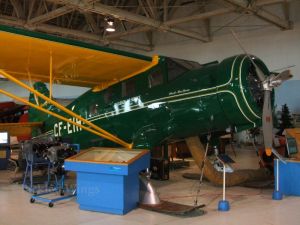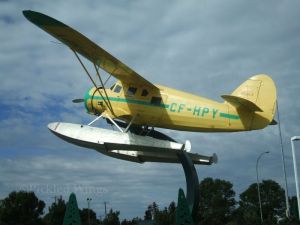
A Niche to be Filled
Canada has a long and storied history of bushflying. While bushflying is not unique to Canada, some of the most significant innovations to this form of flight were made in Canada.
One of those innovations was the Noorduyn Norseman, the world’s first purpose designed bushplane.
Until the Norseman debuted in the mid 1930s, bushflying was a risk filled business of improvising with aircraft that were never intended to operate in the harsh environs of Canada’s north and other remote regions.
The Norseman did not take all the risk out of bushflying, but it was a watershed event in avaition by being the first full bushflying package direct from the factory.
Let’s spend some time with the Noorduyn Norseman:
The Mind Behind the Machine
Dutch born Robert B.C. Noorduyn (1893 – 1959) studied engineering in his native Netherlands and Germany before moving to Great Britain in 1913.
It was while in Great Britain that Noorduyn learned to fly and worked as a draftsman for the Sopwith company and chief draftsman for British Aerial Transport. Shortly after the end of the First World War, he returned home and took up work with the Fokker aircraft company.
In 1921, he was sent by Fokker to America to supervise the set up of the company’s new manufacturing facility there. It was in America that he designed the Fokker Universal, which saw extensive use in Canada’s northern bush.
Noorduyn was later employed by Bellanca where he designed that company’s Skyrocket aircraft which also saw significant use in bushflying. While at Bellanca, he was also deeply involved with the Pacemaker aircraft, an improved follow on to the Skyrocket that was also popular in bushflying.
It was through designing those aircraft that Noorduyn acquired knowledge of what qualities were desirable and required in an aircraft used in harsh northern climates. In 1934, he took it upon himself to design an aircraft specifically targeted to Canadian bushflyers which could be profitably operated and effectively maintained using the existing bushflying skill set.
The new aircraft design incorporated fully interchangeable wheel, ski and float landing gear set ups from the very beginning; there would be no improvising in the field or major redesign work required to make this aircraft ready for almost any landing area the bush could throw at it. The aircraft also featured a heated cockpit and spacious cabin with room for eight passengers.
The prototype Norseman took to the air for the first time in late 1935. Reflecting the intended work environment for the aircraft, it was fitting that the aircraft was fitted with floats rather than conventional landing gear for its first flight.
Into Uniform
Sales of the Norseman were rather slow at first, and it seemed that total production might be rather small as a result. The coming of the Second World War would change that for the aircraft.
Like so many aircraft of the period, the Norseman found itself drawn into military service in World War Two.
The two biggest military operators of the Norseman during the Second World War were the Royal Canadian Air Force and the U.S. Army Air Force. The initial batch of the aircraft built for the RCAF was designated as the Norseman Mk.IV while the U.S.A.A.F version was known as the UC-64. The RCAF purchased a second batch of the aircraft, built to the American standard, known as the Norseman Mk.VI.
Both services used the aircraft in the utility and liason roles. The RCAF put many of the aircraft into the British Commonwealth Air Training Plan (BCATP) as trainers for wireless radio operators.
Many of the qualities built into the aircraft to optimize it for bushflying proved to be very popular and appreciated by military operators. In the post war years, the Norseman was used by the air arms of nearly 20 countries into the late 1950s and early 1960s.
American big band legend, Glenn Miller disappeared over the English Channel while flying from Great Britain to France in a USAAF Norseman in December of 1944.
Another death associated with the Norseman was that of George Beurling, the highest scoring fighter pilot of the RCAF during WWII. Beurling died in 1948 while he was involved with delivering aircraft to the newly formed Israeli Air Force when a Norseman he was flying fatally crashed on landing in Rome, Italy.
Return to Civilian Life
In the years following the war the Norseman went back to doing what it did best, bushflying. In the immediate post war years Norseman production was in the hands of Canadian Car and Foundry and it was through them that the Mk.V, a civilian version of the wartime Mk.IV, was introduced.
Noorduyn eventually bought back the construction jigs from Canadian Car and Foundry in the 1950s. Production of the Norseman ended in 1959 with slightly over 900 built.
The Norseman remained a stalwart of the bush for many years and saw much use flying outdoors enthusiasts into very remote and much sought after camping and fishing sites that could be accessed no other way but by floatplane.
The aircraft also saw use in police work with the Royal Canadian Mounted Police using a number of them for search and rescue as well as patrol work.
The Norseman Today
Of the 900 or so examples built, less than forty are still known to be airworthy as of 2023. While flying examples are known to be on some European and the American civil registers, your best bet to see one flying would be to travel to Canada.
Happily, the town of Red Lake, Ontario, Canada keeps the spirit of this great bushplane alive through the annual Norseman Floatplane Festival every July.
Your chances of seeing a Norseman in a museum are about the same as for flying ones. Around 30 are known to be preserved in museums spread between America, Canada and Europe.
This link will take you to norsemanhistory.ca, a website with a good amount of historical information and photographs about the Norseman.



